Preface: Several cities and towns in Idlib province witnessed a violent military escalation by the Syrian/Russian alliance and its supporting militias during the period from December 25, 2017 to January 20, 2018, when the majority of cities and towns in Idlib were bombarded, in particular, the eastern, southern and south-eastern countryside, with warplanes and various types of weapons. That has resulted in numerous civilian casualties being dead or wounded.
On December 25, 2017, at least seven civilians were killed and others injured as Syrian regular forces shelled Jarjanaz[1], in the east countryside of Idlib, with barrel bombs. About 40 barrel bombs were dropped on the town on the same day, warning of the reuse of barrel bombs tactics in shelling the civilian populated areas.
Moreover, on December 31, 2017, Kafar Sijnah[2] town located in the southern countryside of Idlib, was shelled with high-explosive thermobaric (vacuum) bombs. According to many testimonies obtained by Syrians for Truth and Justice/STJ, a warplane likely to be Russian has carried out airstrikes on the main street in the town while it was full of people, killing eight civilians and injuring dozens.
By the beginning of 2018, specifically on January 2, 2018, a warplane, believed to be Russian, also committed a massacre when it killed six civilians in Khan Assubul[3] in the southern countryside of Idlib, after it bombarded civilian houses with thermobaric (vacuum) rockets, knowing that the town is considered to be a safe place for the displaced fleeing the brutality of military operations.
The attacks also affected the archaeological sites and medical facilities. On January 2, 2018, the archaeological museum in Ma'arat al-Nu’man[4], was bombarded with a warplane, likely to be Russian, causing 80% destruction to the museum. Besides, on January 3, 2018, Salam Hospital also located in Ma'arat al-Nu’man was subjected to shelling by a warplane believed to be Russian, according to testimonies obtained by STJ, which caused the hospital to be completely out of service in addition to civilian casualties, including a newborn child. It should be indicated that Salam Hospital is specialized for children and women.
Attacks by Syrian regular forces and their allies on different areas of Idlib varied. On January 3, 2018, the automatic bakery in Saraqib[5], Idlib countryside, was targeted with rockets loaded with incendiary substances, similar to napalm, resulted in large parts of the bakery to be out of service. In addition, on January 7, 2018, a heavy explosion from an unidentified source occurred in front of the Specialized Salam Clinic of the Sams American System in the center of Idlib[6], killing up to 25 civilian and injuring dozens, as well as causing significant material damage to the clinic.
From January 10, 2018 to January 20, 2018, the Syrian regular forces and their allies continued the military campaign on towns and cities in Idlib countryside, such as Saraqib, Khan Assubul, al-Dier al-Sharki village and Tabish, killing and injuring scores of civilians, including women and children.
This escalation comes from the side of Syrian regular forces after HTS, al-Nusra Front, controlled Abu Dali village in the northeast countryside of Hama on October 9, 2017. However, on December 29, 2017, the Syrian regular forces supported by Russian Air Force warplanes could retrieve this village in addition to other villages in the northern countryside of Hama. Moreover, Syrian regular forces and its allies were able on January 7, 2018, to advance towards the south-east countryside of Idlib and control several villages such as Atshan, al-Khoueen and Sinjar, with the aim of arriving Abu Duhur Military Airbase located in the south-eastern countryside of Idlib. According to STJ researchers, the military operations resulted in controlling the airbase by Syrian government forces and allied militias[7], besides these events coincided with the preparation for the "Syrian National Dialogue Congress scheduled to be held in Sochi, the Russian city, on 29 and 30 January 2018, under the Russian auspices.
It is noteworthy that on May 4, 2017, the sponsoring states of the Astana Talks (Russia, Turkey and Iran) had signed a memorandum of understanding for the establishment of de-escalation zones in Syria, which included Idlib province, some northern parts of Homs province, some parts of the adjacent provinces (Latakia, Hama, and Aleppo), Eastern Ghouta in Damascus countryside, and some parts of southern Syria.
Russia also announced, by its President Vladimir Putin, the withdrawal of a large part of its forces from Syria on December 11, 2017, but with the maintenance of the "Hememim military base" in Latakia and a naval military installation in Tartous province on a permanent basis. The Russian president made the announcement during his visit to the Hememim military base in Syria on the same day.

An illustrative map showing the distribution of control positions in Idlib, until mid-January 2018.
First: Seven Dead in Indiscriminate Attacks on Jarjanaz, Eastern Idlib Countryside
On December 25, 2017, Syrian regular forces and their allies escalated the pace of military operations in various areas of Idlib, as up to 7 civilians were killed and others injured when Syrian regular forces warplanes shelled Jarjanaz town in the eastern countryside of Idlib with barrel bombs. Jarjanaz is about 25 kilometers away from Abu Dali/Abu-Dala village, which has been recently controlled by the Syrian regular forces.
According to STJ researchers, the Syrian regular forces were trying to stabilize their position points in Abu Dali and reinforce their operating headquarter at the Manjazat School east of Soran city located in Hama countryside in order to control the main highway network that controls the region.
According to many testimonies obtained by STJ, the helicopters were launched from the Manjzrat School and dropped about 40 barrel bombs on Jarjanaz on the same day, which was also confirmed by Mr. Mohammad Degheim, the head of the town's local council. He said:
"The shelling was distributed to most residential neighborhoods in Jarjanaz, killing at least seven people and injuring others, including children and women. Jarjanaz is one of the most densely populated towns in the eastern countryside of Idlib, compared to other towns, because it houses approximately 23,000 inhabitants, being native locals or displaced. In Jarjanaz, there are more than 9,000 displaced families from Darya, villages and towns in the south countryside of Aleppo, the east countryside of Hama, and al-Ghab Plain among others. Following these attacks, these families began to flee to agricultural land, or to other villages or to the outskirts of the town itself."
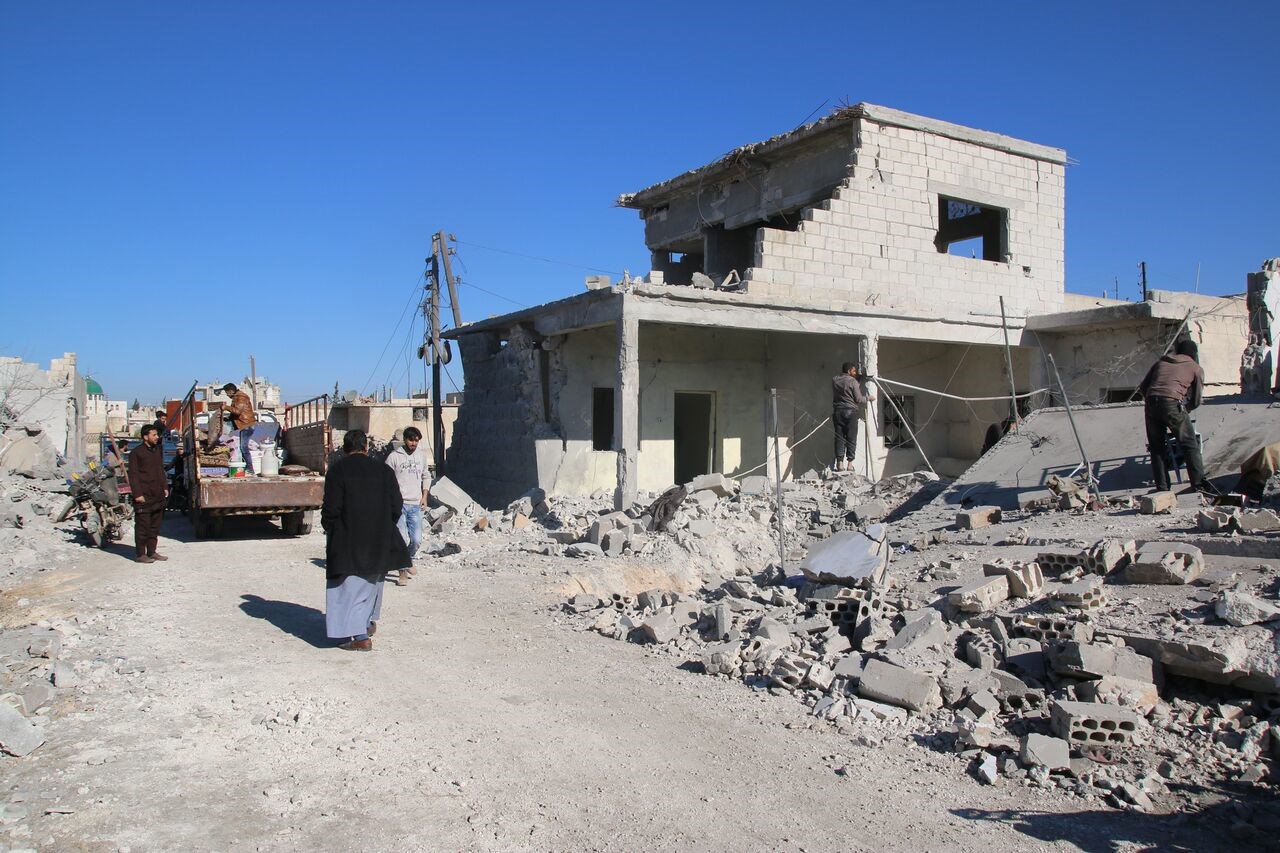
Image shows the destruction affected to some houses in Jarjanaz after shelling it with barrel bombs.
Photo credit: STJ
A video footage published by Khotwa (Step) News Agency on December 25, 2017, showed the aerial bombardment launched on Jarjanaz located in south of Idlib on the same date, killing four civilians and causing significant material damage.
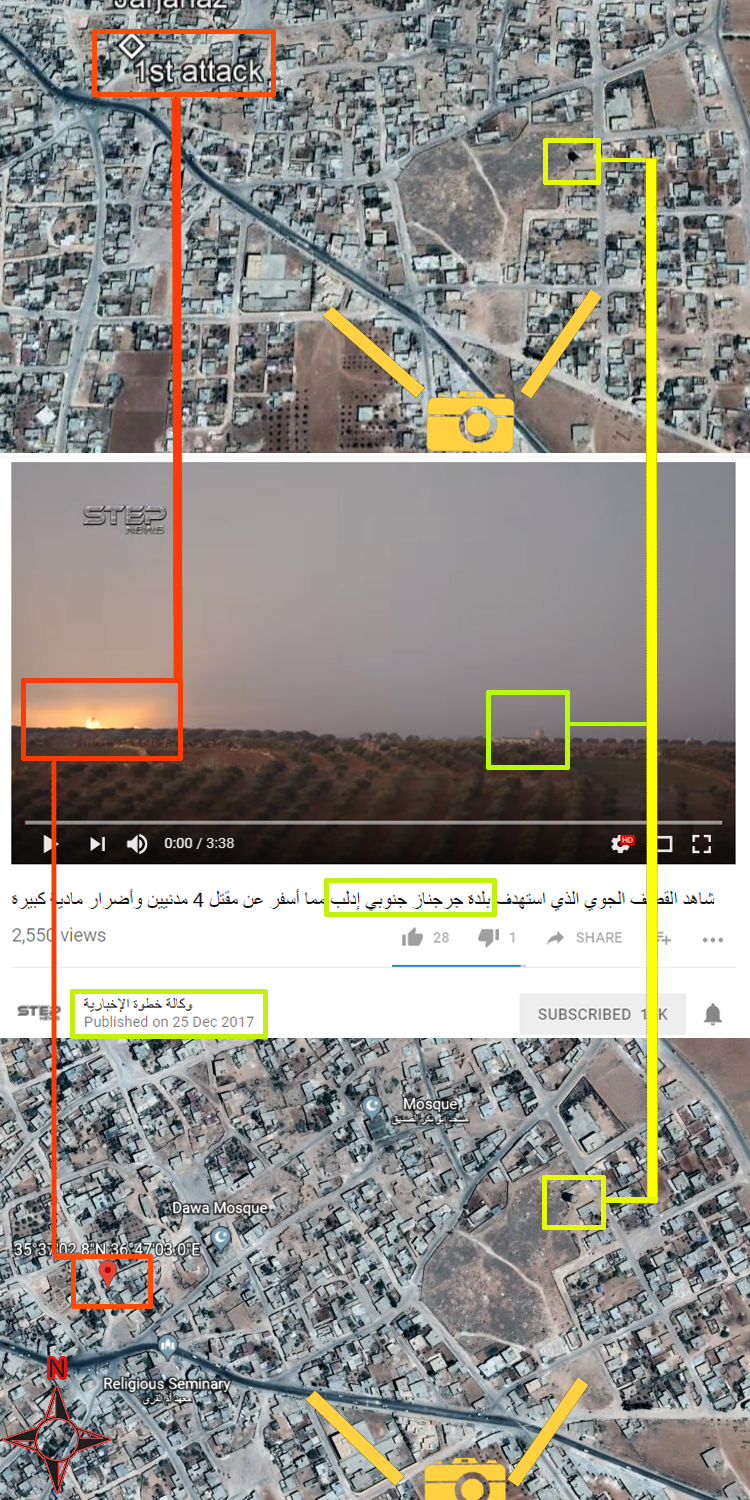
Analysis of visual evidence showing the strike location of several raids with barrel bombs in Jarjanaz/Idlib.
Second: Thermobaric Rockets Kill Eight Civilians in Kafar Sijnah in the South Countryside of Idlib
The humanitarian situation worsened in various areas of Idlib as a result of the recent military campaign carried out by the Syrian regular forces and its allies, especially in the southern countryside of Idlib. On December 31, 2017, Kafar Sijnah was subjected to several airstrikes targeting the main street, which is usually full of locals and displaced, and according to many testimonies obtained by STJ, the warplanes raided the town with thermobaric (vacuum) rockets, killing eight people, including children and internally displaced persons, and injuring dozens, in addition to causing considerable material damage to civilian property.
Concerning the recent attack, Abdrrazaq Sbeih, an activist from Kafar Sijnah, talked to STJ:
"At 1:30 p.m., the regime warplanes targeted the main street in the town, which is usually full of people as it contains a large number of shops, which have resulted in killing three children from Kafar Sijnah, as well as several displaced persons from Hama and Idlib countryside, besides it caused fires in shops and in civilian houses. The Civil Defense teams worked to extinguish fires and help the injured and pull out the dead from under the rubble. It is remarkable that Kafar Sijnah is one of the towns that houses hundreds of displaced families from Hama countryside and the south-eastern countryside of Idlib, so this attack shows that the Syrian regime is targeting places of displaced communities in villages and towns of Idlib countryside."
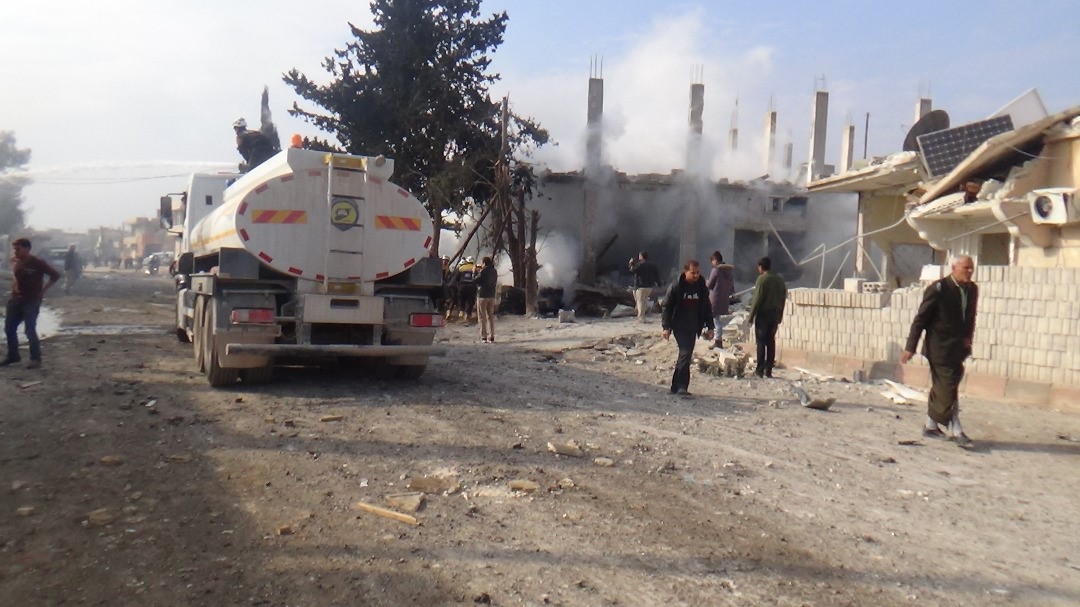
An image shows the extent of devastation affected to the main street in Kafar Sijnah in the south countryside of Idlib following targeting it by Syrian regular forces warplanes on December 31, 2017.
Photo credit: STJ
A video footage televised on December 31, 2017, by Orient TV showed the extent of devastation affected to the main street in Kafar Sijnah and the deaths and injuries caused by the Syrian regular forces shelling.
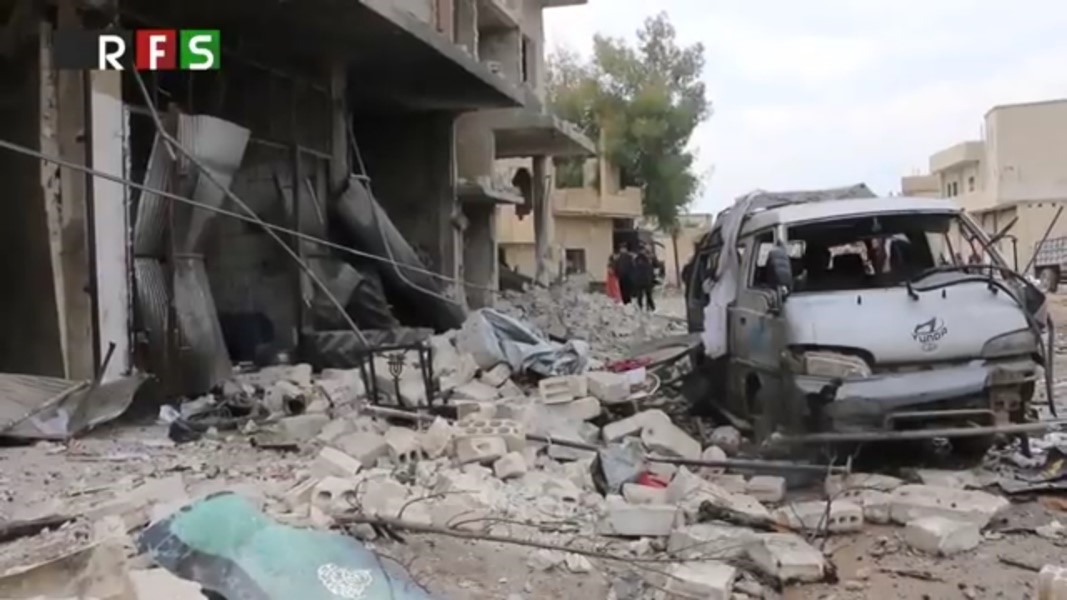
Image taken from a video footage published by of the Revolutionary Forces of Syria Media Office which shows the strike location of a thermobaric rocket that targeted the main street in Kafar Sijnah.
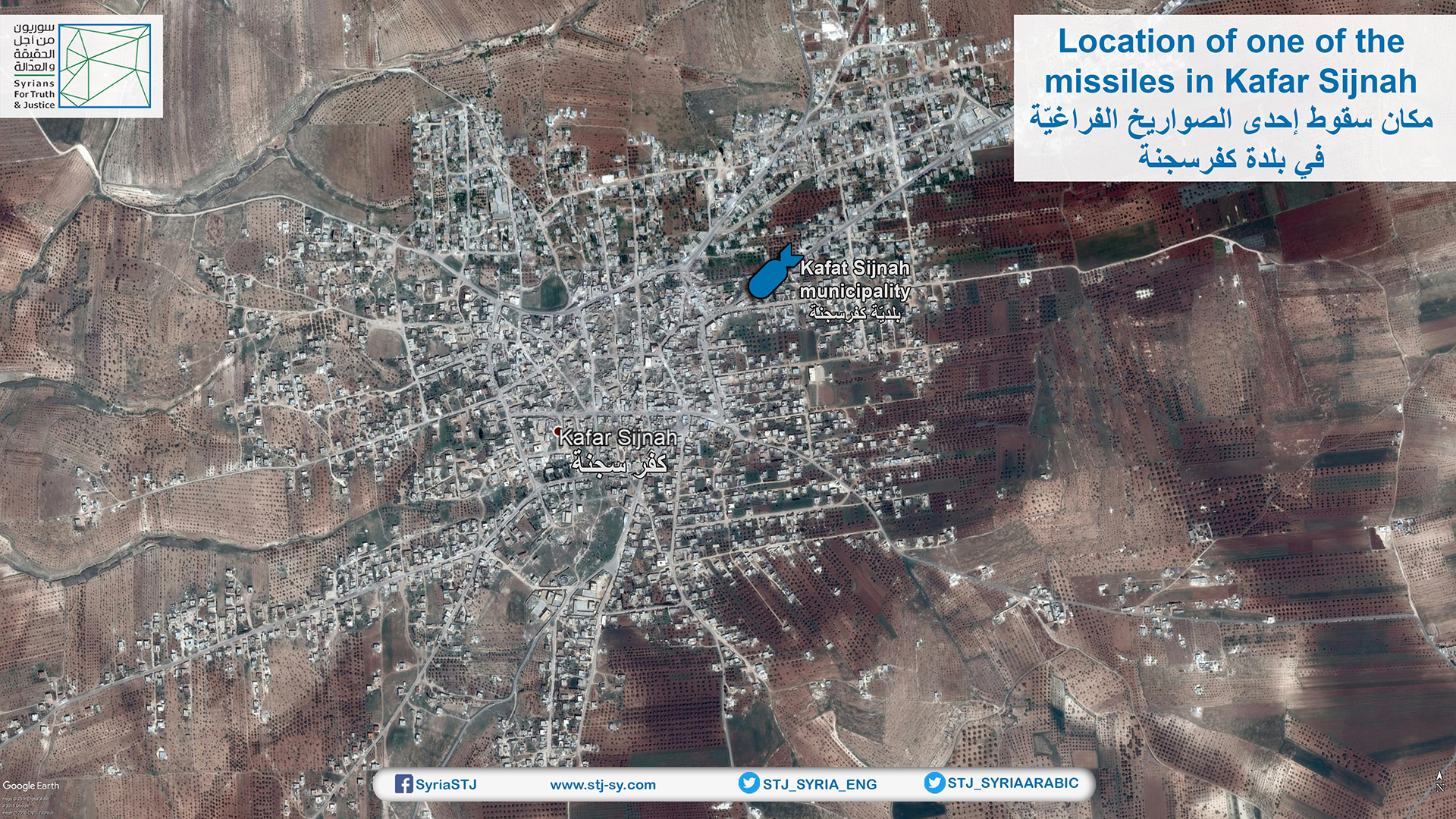
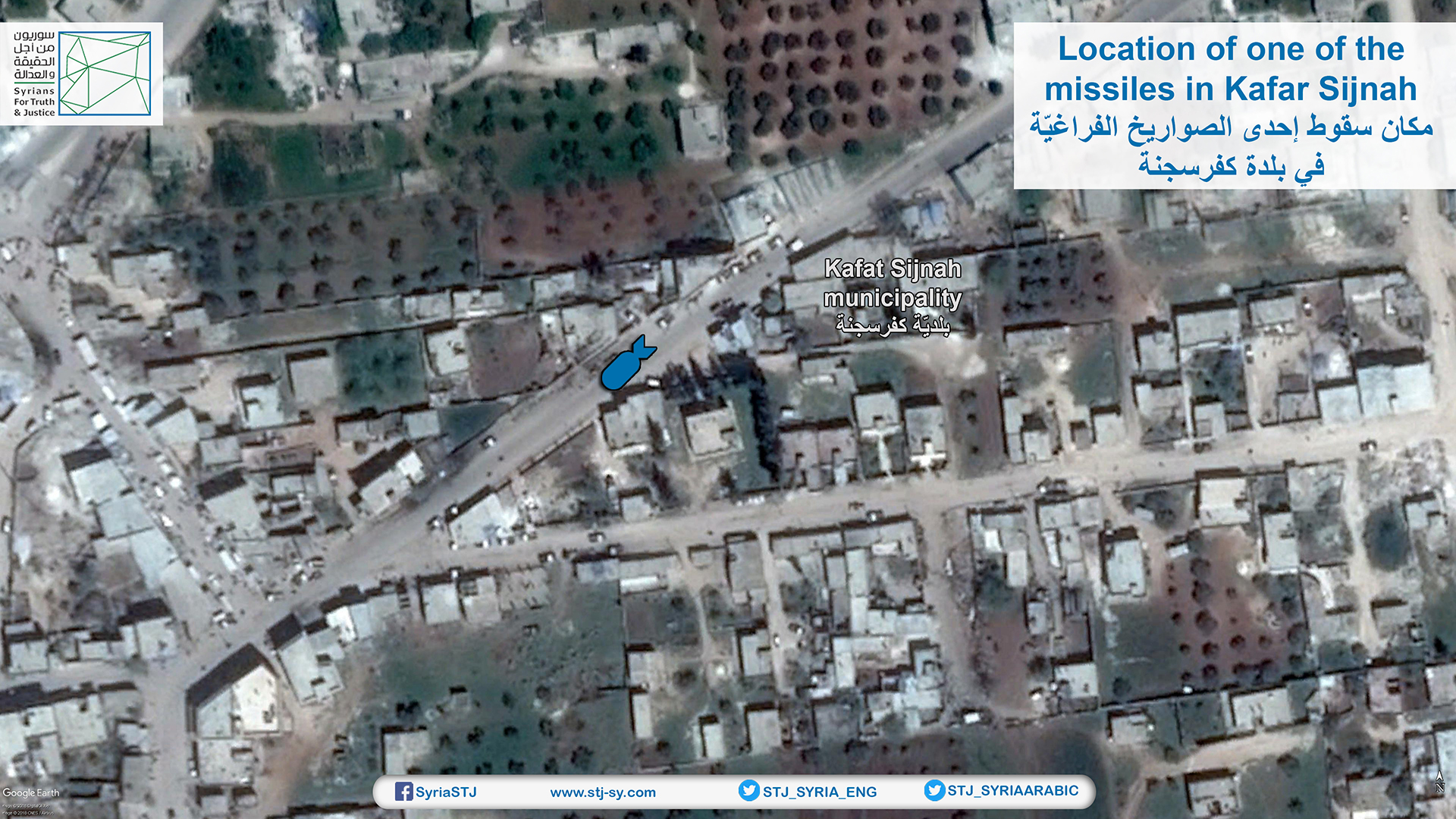
A satellite image shows the strike location of a thermobaric (vacuum) rocket in Kafar Sijnah.
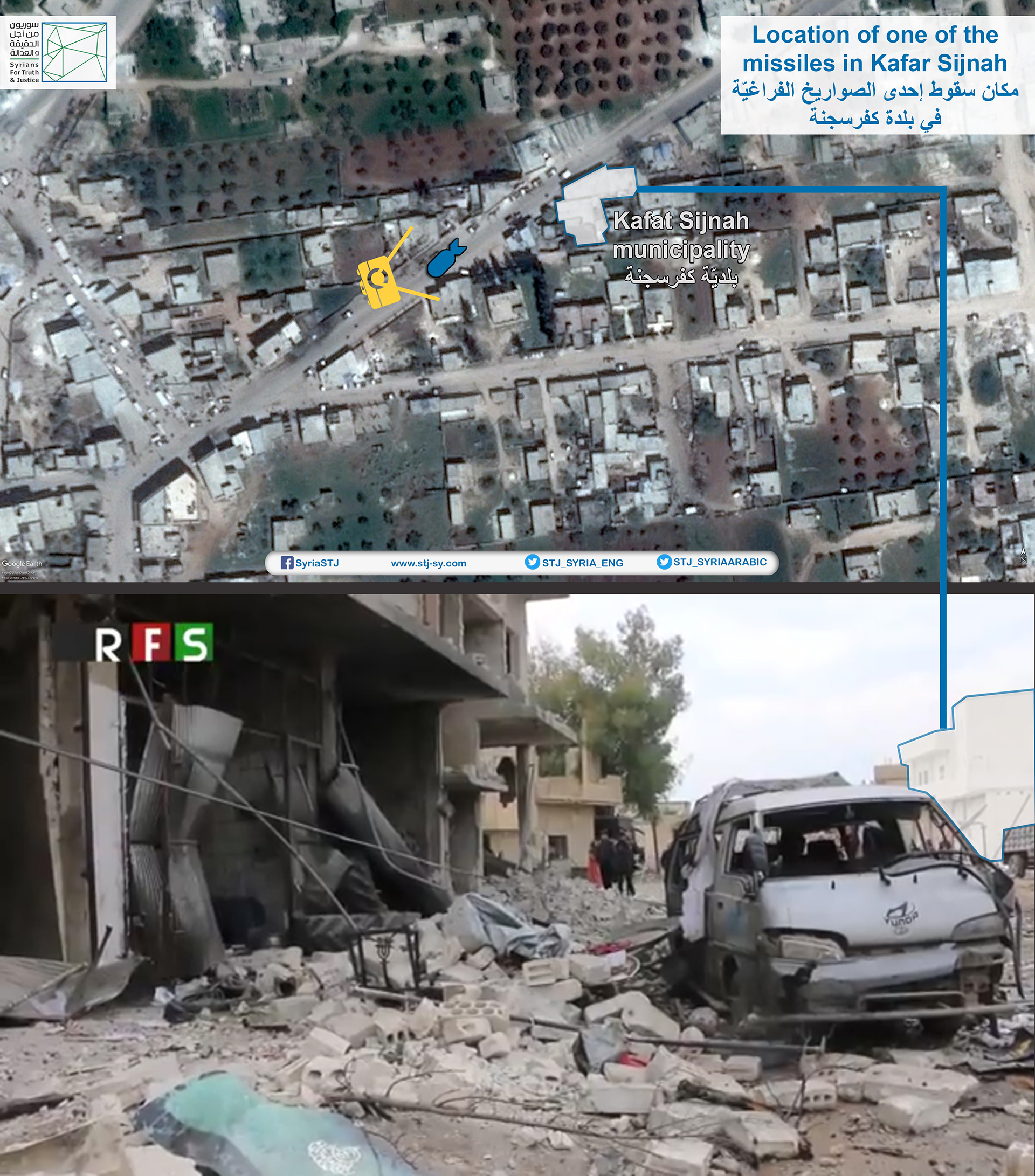
Analysis of visual evidence
Third: Dozens of Victims in Bombardment with Thermobaric Rockets on Khan Assubul in the South Countryside of Idlib
On January 2, 2018, Khan Assubul, which is about 10 km away from Saraqib, was subjected to bombardment with warplanes believed to be Russian, according to testimonies obtained by STJ. the warplanes carried out six air strikes loaded with high-explosive thermobaric (vacuum) rockets, the majority of them fell on civilian homes in Khan Assubul, killing 7 civilians, including 5 children and 1 woman, as well as injuring 16 others. It should be mentioned that Khan Assubul is considered to be a safe place for many displaced persons fleeing the brutality of military operations between the armed Syrian opposition forces and the Syrian regular troops in both Hama countryside and Idlib countryside.
Mohammed Haj Hasan, a displaced who was there at the strike location when it occurred, talked to STJ:
"At 4:00 p.m. warplanes raided Khan Assubul and carried out the first attack with four rockets at one time, targeting the farms scattered over the outskirts of the town, resided by displaced persons. Five minutes later, the warplanes re-targeted the town and carried out other raids, killing a whole family, including women and children. The toll of the massacre was 7 dead, in addition to more than 10 wounded; their injuries ranged from medium to light."
Abdlkarim Mohammed, a paramedic who hurried to the strike location after it occurred, talked to STJ:
“We learned through the observatories, which monitor the movement of warplanes in the town's skies, that the aircrafts that targeted the houses of the displaced were Russian aircrafts. Immediately we headed to the strike location and there was a state of panic among most people, notably that the town is a safe place for the displaced, and it has not been bombed for several months. Once we arrived, we started to rescue the injured and move them to the medical points, noting that most of the dead and wounded were from the internally displaced persons and were not residents of Khan Assubul.”
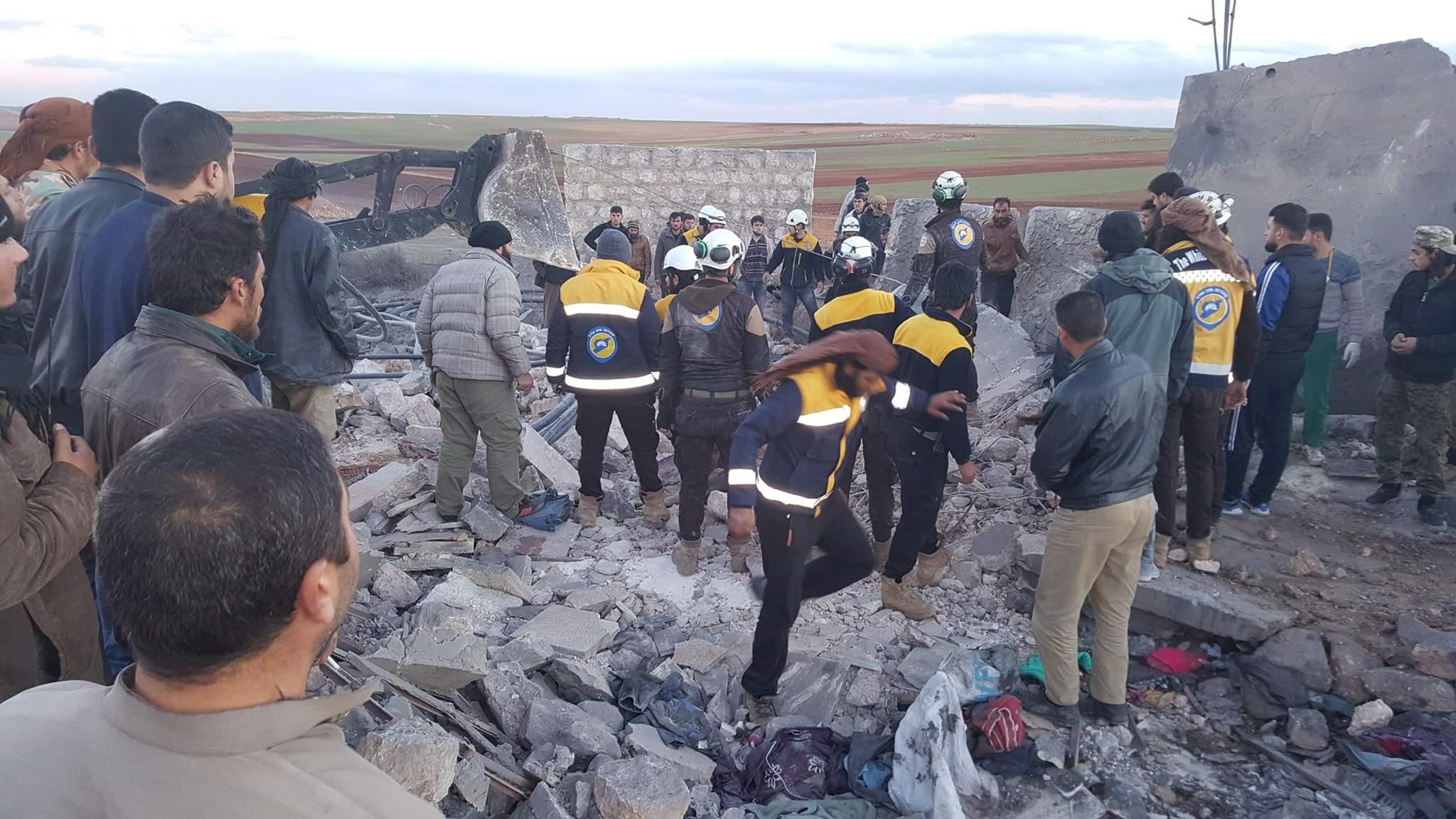
Image shows the damage affected to the houses of displaced civilians in Khan Assubul, as a result of the shelling on January 2, 2018, by of a warplane believed to be Russian.
Photo credit: STJ
A video footage published by Ittihad News Agency on January 2, 2018, claimed that it was the moment of targeting Khan Assubul with a warplane believed to be Russian.
Fourth: Targeting Archaeological Sites and Medical Facilities in Idlib Countryside
On the same day, January 2, 2018, the archaeological museum, located in the south-east of Ma’arat al-Nu’man, was shelled with high-explosive thermobaric (vacuum) rockets causing destruction of 80%. According to a member of the local council in Ma’arat al-Nu`man, a military warplane, likely to be Russian, raided the museum, which dates back about 500 years in the Ottoman area, that resulted in the destruction of artifacts inside. However, Syrian regular forces and its allies had previously bombed the museum more than once.

Image shows the big damage affected to the archaeological museum in Ma’arat Nu’man, as a result of shelling it on January 2, 2018.
Photo credit: STJ
On January 3, 2018, warplanes of the regular forces and their allies also shelled medical facilities in Idlib countryside, as a warplane believed to be Russian shelled Salam Hospital in Ma’arat al-Nu’man as well, caused the hospital to be completely out of service, killed four civilians, including a newborn child, and wounded 10 from visitors and medical personnel, according to many testimonies obtained by STJ. In this connection, Abdel Al-Monem Shardoub, the Director of Salam Hospital, talked to STJ saying:
"Salam Hospital is a specialist hospital for children and women, as it used to serve Ma’arat al-Nu’man and its countryside. Anyway, it received about 12 thousand cases a month, as well as performing (30) giving birth operations every day, as there were about 20 incubators. The pressure on the hospital has increased recently, due to the large displacement in eastern Idlib countryside, as well as getting most medical points out of service as a result of the fierce attack conducted by Syrian and Russian warplanes. At 12:00 p.m. on January 3, 2018, the hospital was directly targeted by percussion rocket of the Russian warplane, that caused the hospital to be completely out of service, and killed four visitors, including a newborn girl baby, apart from injuring five medical personnel. Concerning the material damage, the raid destroyed the operating room and the incubators as well as causing great damage to the medical equipment."
In another testimony, Hadi Abdallah, the activist, told STJ that a military warplane likely to be Russian had targeted Salam Hospital in Ma’arat al-Nu’man, noting that he had rushed to the impact site at once, and was shocked by the huge destruction of the hospital, as well as the injured and the dead who were in a dire condition.
A video footage, published by the activist Hadi Abdallah on January 3, 2018, showed the devastation of Salam Hospital in Ma'arat al-Nu’man, as a result of shelling it by a military aircraft believed to be Russian.
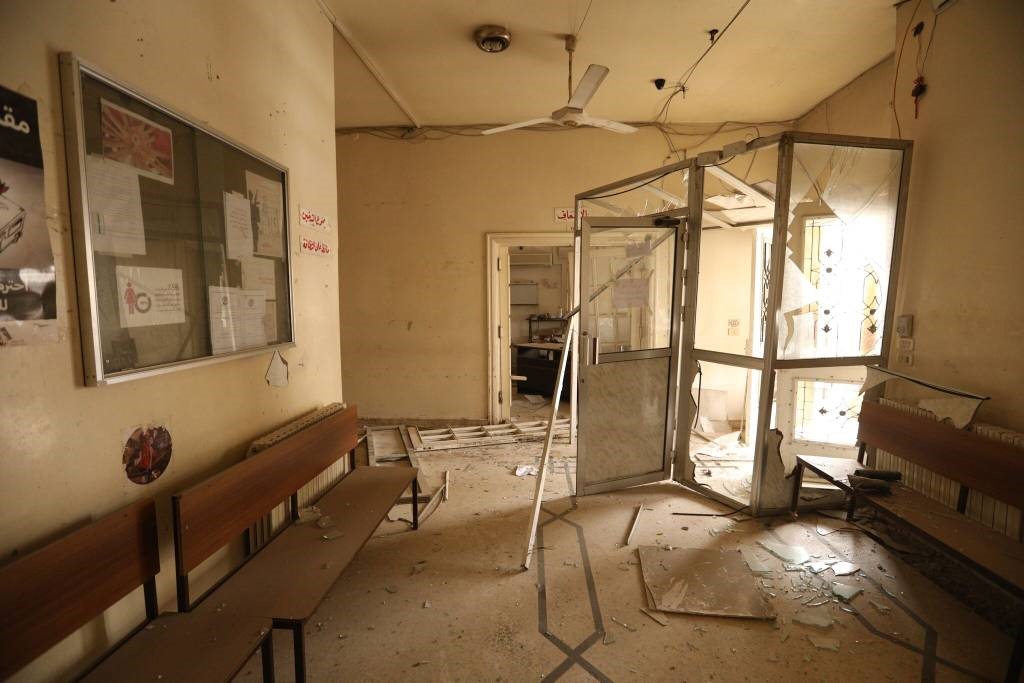
Image shows the devastation affected to Salam Hospital in Ma’arat al-Nu’man due to shelling it on January 3, 2018 by a military warplane, believed to be Russian.
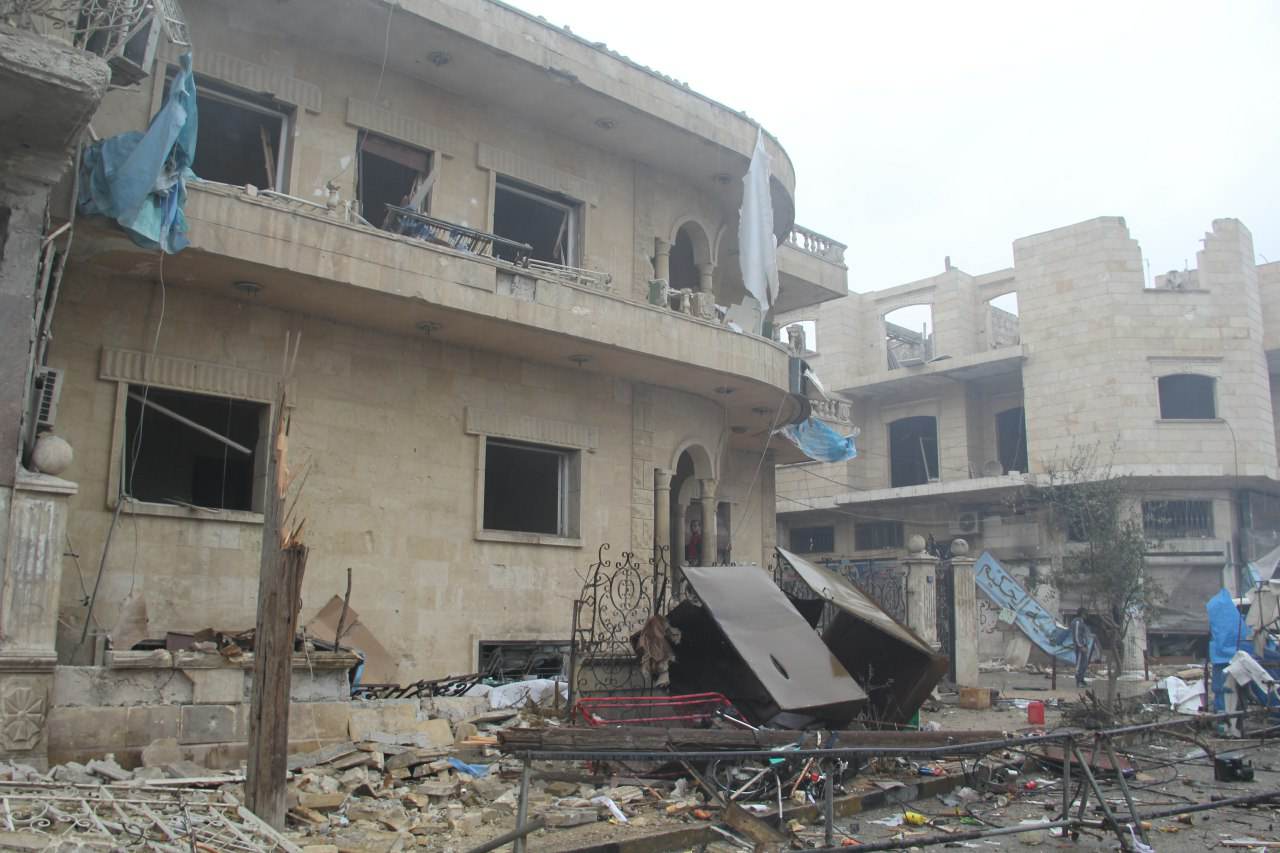
Image showing the location of the percussion rocket landed next to Salam Hospital in Ma’arat al-Nu’man.
Photo credit: Ma’arat Media Centre.
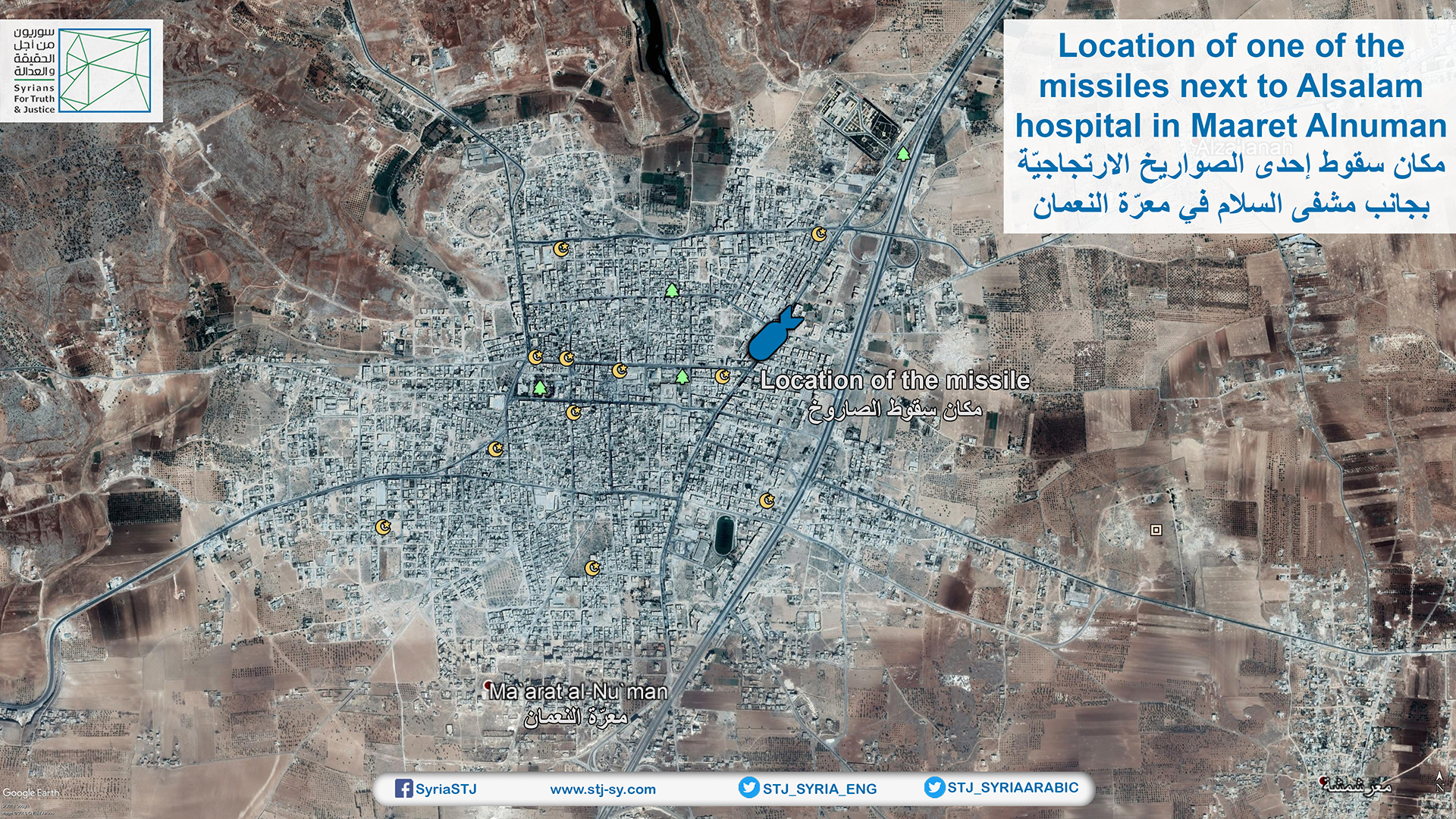
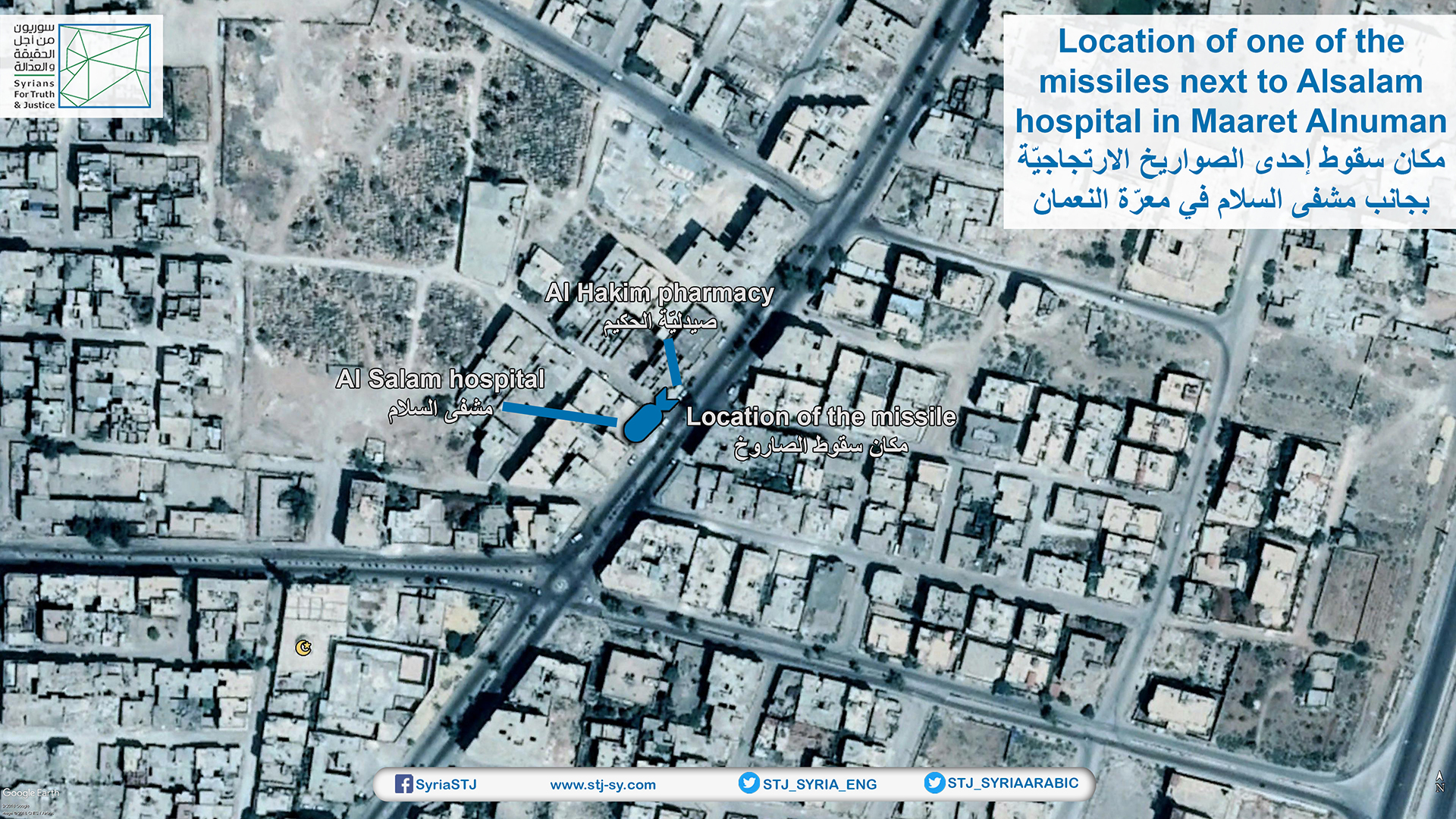
Satellite image showing the location of the percussion rocket on Salam hospital in Ma’arat al-Nu’man.
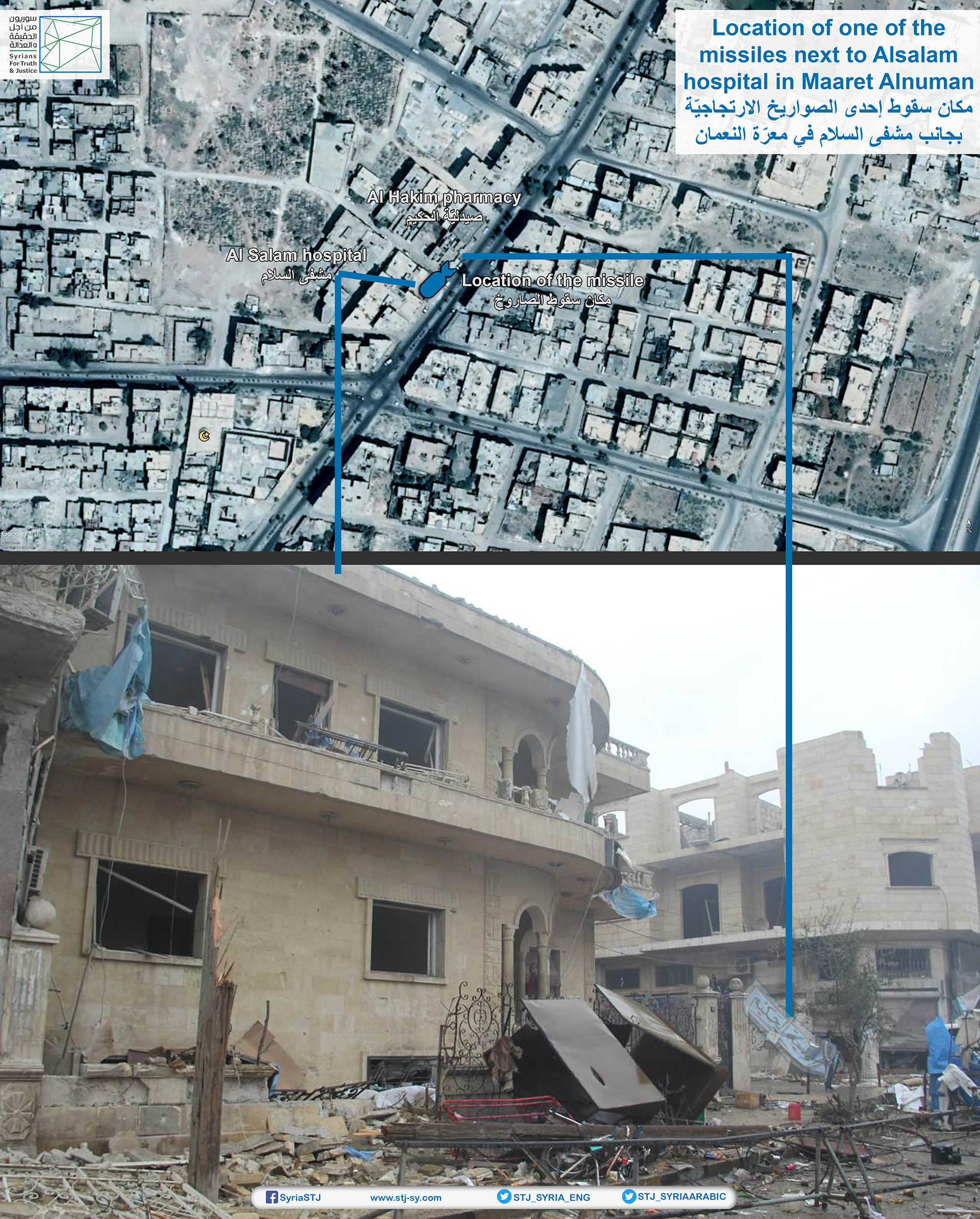
Analysis of visual evidence
Fifth. Violent Attacks on Various Parts of Idlib
The attacks that carried out by the Syrian regular forces and their allies varied in different areas of Idlib. However, according to many testimonies obtained by STJ, at 11:30 p.m. on January 3, 2018, the automatic bakery was targeted in Saraqib city, Idlib countryside, with rockets loaded with incendiary substances (similar to napalm), which resulted in wounding three civilians and getting large parts of the bakery out of service, as well as depriving more than 3, 000 people of bread, according to STJ researchers.
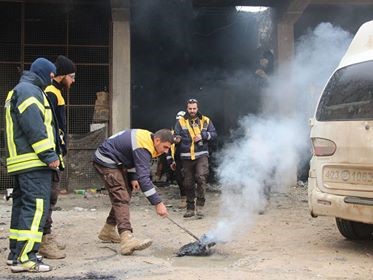
Image showing a side of the Civil Defense team working to dispose remnants of the incendiary bombardment on the automatic bakery in Saraqib on January 3, 2018.
Photo credit: Civil Defense in Idlib.
On January 7, 2018, a massive explosion from an unidentified source occurred in the center of Idlib city, specifically on 30 St/Ath-Thalatheen Street, killing more than 25 civilians and injuring others, according to what Mohammed al-Yousef, an activist from Idlib, who was present near the explosion site, said:
"The explosion occurred near Salam Medical Centre of the American Sams System, which served almost 1,500 sick women and children per month. However, at 8:30 p.m. on January 7, 2018, while I was very close to 30 St/Al-Thalatheen Street in Idlib, I heard a loud explosion, so I rushed to see what happened, I was shocked by seeing bodies of the dead scattered everywhere. As for the material damage, it was incredible; Salam Clinic (Sams) building was also damaged and was completely out of service. However, according to the Civil Defense and the emergency teams, who arrived at the site, the shelling was conducted by rockets fired from warplanes or long-range missiles; whereas some residents said it was caused by a car bomb."
STJ learned from ıts reporter that the faction that calls itself Ajnad Al-Qoqaz had a military headquarter near the explosion site, and one of their agents was killed in the attack as well. He added that locals had repeatedly asked them to get out of the neighborhood.
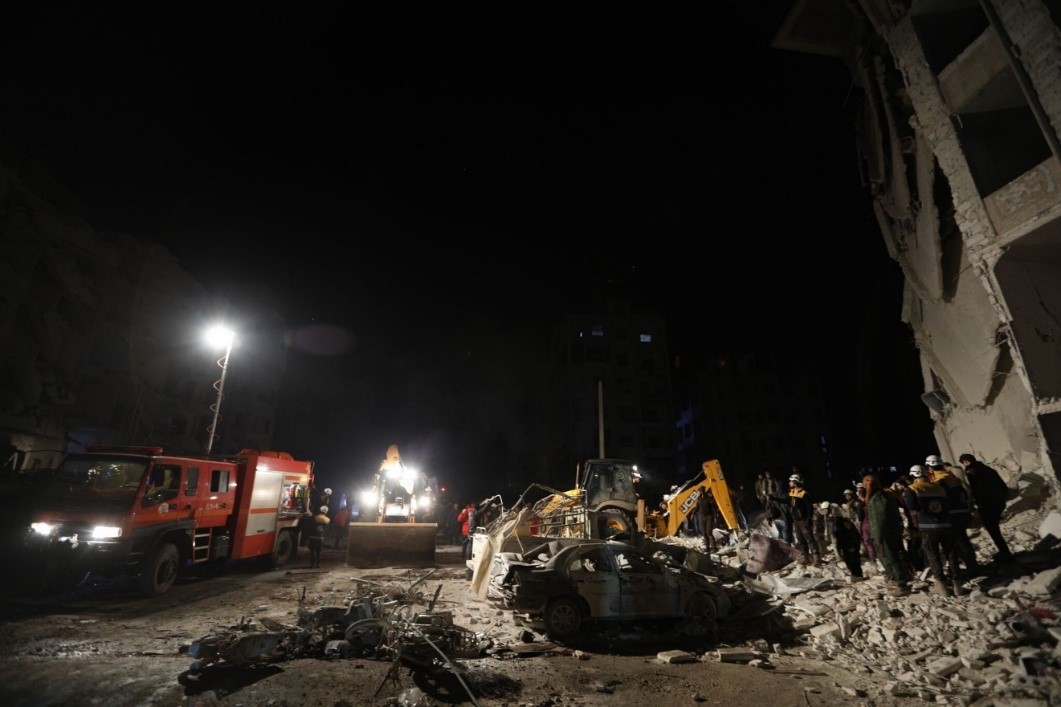
Image shows the tremendous damage affected to Salam Clinic of the Sams American Medical System as a result of an unidentified source explosion in front of the clinic on January 7, 2018.
A video footage published by Civil Defense on January 8, 2018, shows some attempts to put out the fire caused by an unidentified source explosion in the center of Idlib city on January 7, 2018.
At 10:00 p.m. on January 7, 2018, the road, that links the village of Tell Mannas and Jarjanaz in the eastern countryside of Idlib, was targeted, when warplanes believed to be Russian shelled "Falul Farms" that is densely populated area by displaced families. According to many testimonies STJ obtained, the warplanes carried out eight airstrikes loaded with vacuum rockets on the Falul Farms killing 12 people and injuring dozens.
Sixth: Dozens of Victims Including Children and Women in Shelling Cities and Towns in Idlib Countryside
Syrian regular forces and their allies continued their military campaign against towns and cities of Idlib countryside. STJ researchers confirmed that on January 11, 2018, the whereabouts of Minister of Health of the Syrian Interim Government/Syrian Opposition Coalition in Ma’arat al-Nu’man was targeted by a warplane believed to be Russian, killing his driver and wounding some civilians.
On January 13, 2018, the town of Khan Assubul was again shelled by Russian-likely warplanes killing 9 civilians, including children and women, as
According to STJ researchers, on January 14, 2018, al-Dier al-Sharki, in the southern countryside of Idlib, was shelled by a ground- to- ground missile loaded with cluster munition fired by the Syrian regular forces from the area of Daher Alksair located in western Homs, injuring (4) civilians.
On January 16, 2018, at least seven civilians, including children, were killed in shelling by a Russian likely warplane on Tabish near Khan Shaykhun in Idlib countryside, this was confirmed by STJ. In addition, a video footage of the Civil Defense in Idlib shows part of the evacuation of those who were injured in shelling Tabish on January 16, 2018.
The aerial bombardment campaign on many villages and towns of Idlib countryside continued, and according to many testimonies obtained by STJ that on January 17, 2018, a warplane, likely to be Russian, conducted an aerial attack on Saraqib by rockets loaded with cluster munitions and incendiary substances injuring many civilians. A video footage of the Civil Defense, in Idlib countryside, showed the fires that had erupted because of the attack.

